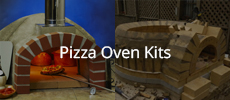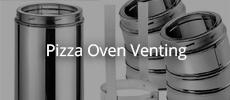I see an ove glove purchase in the near future ;}
Sable springs- thank you for the info, very helpful!
Announcement
Collapse
No announcement yet.
Another curing question
Collapse
X
-
Well we lit the first curing fire yesterday and overall it went well. I had completely forgotten about the briquette method so the very top of the oven of course got hotter than 150 degrees so to remedy that quickly I just spread the fire out a bit wider amongst the floor. I also fabricated a door out of heavy gauge 1/8 steel scrap on Saturday. The slot on the right was already there so i just left it as a peek hole. Next fire I will have a bag of briquettes for sure.
Leave a comment:
-
There will be always be a difference in temps at the top of the dome and the lower sides. Obviously the apex will be the hottest. Curing is primarily about driving out the moisture as you know, so as the bricks/mortar dry out they heat up more quickly. When I fire my oven, the clearing always progresses from the top down. Take your temp readings in the top third of the dome for the first several firings, you want to minimize the difference between the top section and the next section down. By taking temps high & low, you can better control the temp disparity.
Spreading your briquettes out closer to the sides help heat the oven more evenly as you coax the heat to flow up the side walls instead of letting it head straight up to the top. As your oven starts to dry out, the normal breathing & heat flow of the dome design will naturally move that heat more evenly.throughout the oven. As Russell pointed out, too many new ovens are heated too quickly because it's such an initially slow process to drive that moisture out. Since the amount of contained moisture varies so much between build materials, climate, and provision for moisture escape routes...curing timetables and temps are mainly a generic guide.
Ovens that pick up moisture over the winter or wet season will generally need a couple low, slow fires to bring them back to good, working order. That's why you want to provide some sort of protection from the elements... Especially the insulation areas as they tend to readily absorb water (thankfully, newer materials are helping reduce that problem... hopefully the cost of those newer types of insulation will come down in the future).
Hope this info helps...just go slow & don't stress. There will be cracks, but the structural design has proven to be solid over thousands of years! Relax!
- Likes 1
Leave a comment:
-
The dome should be insulated but before you start the cure, this helps moderated the temperature differential between the inside and outside of the dome to help minimize cracking. Also, the use of BBQ briquettes is a good place to start, no direct flame and gets the oven to about 200 f. Slow and low is how you cure an oven. People get too impatient at this stage and go too fast too hot and damage their ovens.
Leave a comment:
-
Yes, very good idea. You could start with a heat lamp or a propane burner on low for a few days.
-
Hi all, I plan on finishing my build around mid to late October. My question is, as we get into the later , colder months and the dead of winter, I'm guessing firing the cold brick oven will cause massive thermal shock and potential cracking. I'm assuming its a good idea to begin very slowly with a low heat fire for a while in the winter months, or should it not be used at all?
Leave a comment:
-
Relax, it will work just fine. There are many ways to build pizza ovens and most work just fine. The barrel arch design works well and you will make great pizzas. Sure, you can build an excellent oven for a lot of money, a good oven for a lot less or a mediocre one for cheap. They all work, some just better than others.
- Likes 1
-
Sorry, I don't want to dampen your enthusiasm, but an oven to cook a few pizzas in needs to be pretty efficient. Why go through a wheelbarrow full of timber, taking three hors to heat up just for 3 pizzas?Originally posted by pmgnut View PostI've come too far and spent too much $$ to stop at this point. On mine, I did in fact make the back wall out of firebrick. All joints are done with heat stop 50. I do plan on making a removable door to keep some heat inside. There will also in fact be a layer of ceramic insulation over the vault before we lay the red bricks over it. Reading the above post is very disappointing, we've put so much into this. We will just have to make the best of it. { we are not after a commercial pizza oven, just something to cook a few pies on the weekend}
I recall a similar uninsulated barrel oven at a house where I was catering with my mobile oven. Being somewhat sceptical about the barrel oven which the owner had never used, I fired mine up at the same time as the barrel oven. Mine was ready to cook pizzas in an hour and a half, but the barrel oven hadn't even burnt off any of the sooty carbon at the crown after two hours, so we gave up.
The improvements you've made should help the performance. Try it out and in the meantime research flue galleries to perhaps convert the oven to a cross draft system which would reduce fuel consumption, vastly improved circulation leading to faster and higher temperatures with far less heat loss.
-
What you've done will work just fine, it may not be the most efficient, or the easiest oven to cook a pizza in, but the improvements you've made: insulating the floor, using firebrick top bottom back and sides, and adding insulation on top are all great enhancements that will let you get to temperature in two to three hours. That's enough to make pizzas and if you decide to improve it further down the road, this community will help you get there.
- Likes 1
-
I've come too far and spent too much $$ to stop at this point. On mine, I did in fact make the back wall out of firebrick. All joints are done with heat stop 50. I do plan on making a removable door to keep some heat inside. There will also in fact be a layer of ceramic insulation over the vault before we lay the red bricks over it. Reading the above post is very disappointing, we've put so much into this. We will just have to make the best of it. { we are not after a commercial pizza oven, just something to cook a few pies on the weekend}
-
I've only just viewed the video for the first time and there are a number of deficiencies in the design.The internet abounds with videos of easy to build ovens that are poorly designed and I think you have found one.
1.There appears to be no underfloor insulation. Failure to insulate under the cooking floor results in massive heat loss by conduction and it's doubtful you'd get the floor up to temperature in under three hours let alone hold it there.
2. Flue in the crown of the vault results in the oven operating as an updraft system. This means the flame will jump straight to the flue entry and a lot of heat will be lost as well as resulting in poor circulation and high fuel consumption.
3. The rear wall appears to recommend red brick rather than fire brick. As the back of the oven will be the hottest Those redbrick will be subjected to extreme temperature, they should be firebricks.
4. The rear wall is not tied in to the vault. Corners should be tied in as Sixto's suggestion.
5.The second layer of bricks appear to be laid directly against the first layer which, whilst providing good strength, results in massive thickness and thermal mass that requires ages to heat, excessive fuel consumption and hours of firing.
6. No insulation over the vault. It is doubtful that you'd get this oven up to proper pizza temperature.
7.Exceptionally wide oven mouth. This also results in massive heat loss as well as smoke escaping out the mouth rather than up the flue.
As you've already come this far it's probably unrealistic to start again, so finish your build and start using the oven, then from that experience you can start planning another build. There are plenty of barrel oven builds well documented on this forum for research.
-
In the video, they rotated the second layer of bricks to avoid aligning any joints which is important if you are mortaring both layers together, (without insulation) but since you're adding insulation, you can orient the red bricks any way you want, what I would not do, is add mortar between the fiber blanket and the bricks... the blanket is soft, so you don't want to mortar against it. I would not recommend chicken wire either. What is really happening is that you'll be wrapping your current oven with a layer of insulation and another layer of bricks. Essentially, you will have two independently supported barrel vaults, one above the other - separated by an inch of insulation, The red bricks will be mortared to each other, and to the concrete base. Also I'd make sure the back layer (which I did not sketch) is also separated from the firebrick and insulated, since that's where you'll be building the fire.Originally posted by pmgnut View PostOk so I ordered a roll of ceramic insulation. Next question: Do I need to add poultry wire over top of that before laying my red bricks? Also, I'm assuming I should lay the red bricks with both a mortar bed and head joint?
I would make the red-brick arch stronger by turning the corner with bricks at 90 degrees around the front and back arch, and that could conceal your insulation gap completey while also making the outer arch stronger structurally (the effective depth of the arch at the ends would be 9" thick.which is similar to what I did over my entry arch, I have no mortar in between the two arches, only insulation and a rope gasket. See sketches below for how I would go about it.
P.S. I did some research about this type of oven, and it confirmed my suspicion that it's more suited to grilling and roasting than baking pizza. Something about the combustion-air flowing-in cools the floor where the pizza is at, and the hot exhaust air flowing out towards the flue lets too much heat escape the cooking area... Not that you can't cook pizza in it (I've done it in my weber grill) but you'll be using a lot of wood to get to temperature.
Last edited by Sixto; 09-08-2022, 02:02 PM.
-
Adding a layer of chicken wire over the blanket will add unneccary work IMO because you plan on covering it with another brick layer that will hold it in place. The usual thickness is three one inch layers. If it were mine I would have at least up to half the oven height with loose perlite to save money with the blanket on the top half.





Leave a comment: